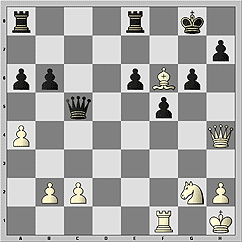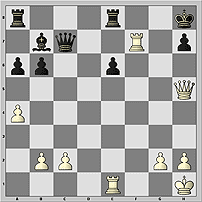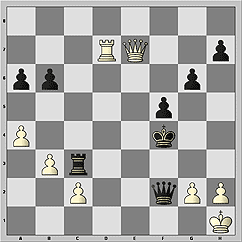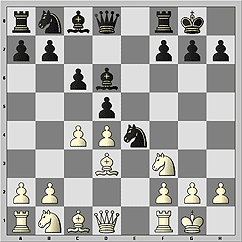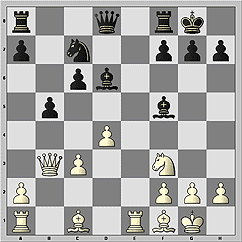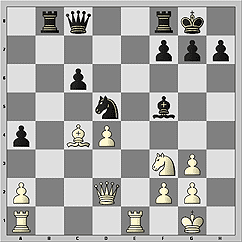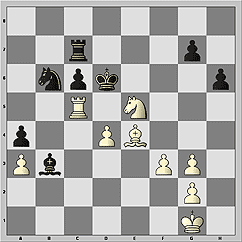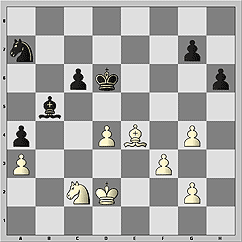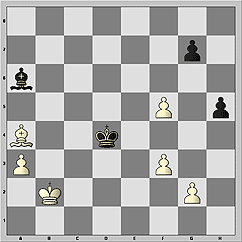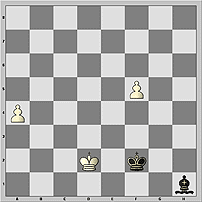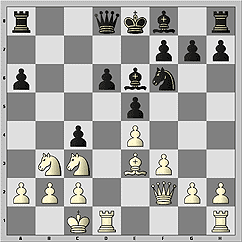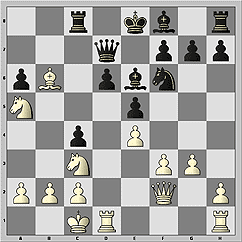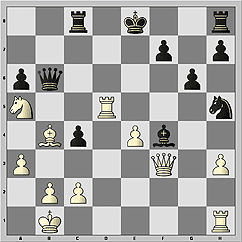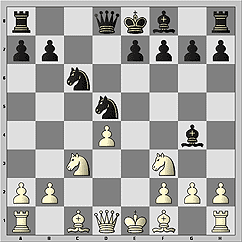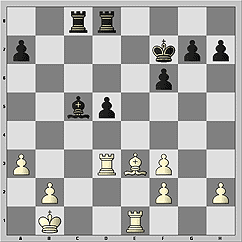 | Последние турниры |
Чемпионат России
СуперФинал

02.12.2006
Суперфинал чемпионата России проходит в Москве, в ЦДШ им. М.М.Ботвинника со 2 по 15 декабря при 12 участниках по круговой системе.
Крамник - Fritz

25.11.2006
С 25 ноября по 5 декабря в Бонне чемпион мира Владимир Крамник сыграет матч из 6 партий с программой Deep Fritz. В случае победы Крамник получит 1 миллион долларов, тем самым удвоив свой стартовый гонорар ($500000).
Мемориал Таля

5.11.2006
В Москве с 5 по 19 ноября проходил Мемориал Таля, в программе которого супертурнир 20-й категории и выдающийся по составу блицтурнир. Призовой фонд каждого состязания - 100.000 долларов.
Топалов - Крамник

23.09.2006
После того как "основное время" не выявило победителя (счет 6:6), 13 октября соперники сыграли 4 дополнительных поединка с укороченным контролем времени.
Томск. Высшая лига

2.09.2006
Со 2 по 11 сентября Томск принимает Высшую лигу чемпионата России 2006 года. В турнире участвуют 58 шахматистов - как получившие персональные приглашения, так и победившие в отборочных состязаниях.
Майнц

17.08.2006
В последние годы фестиваль в Майнце вслед за "Амбер-турниром" стал центром легких шахматных жанров. Наряду с массовыми ристалищами традиционно проходят чемпионские дуэли.
Россия - Китай

10.08.2006
С 10 по 20 августа в Китае проходит товарищеский матч сборных России и Китая. В нынешнем поединке как мужчины, так и женщины соревнуются на пяти досках по шевенингенской системе в два круга.
Все материалы
ChessPro

|
|

|
|
 |
By grandmaster
Sergey SHIPOV |
Pursuit begins! Isn’t it too late? |
At last, the situation changed a bit! The gap between a leader and his pursuers shrank. But the finish is too close – only three rounds to go. Svidler and Anand can only reckon on Topalov’s defeat. Vishy can’t help it anymore whereas Svidler still has a chance to heighten the tension at the finish. But he has to beat the invincible Topalov with Black to achieve this goal.
It’s clear how important the first game between Svidler and Topalov was. Just imagine for a moment that its result was not 0-1, but 1-0…
In this case the Russian grandmaster would have been a leader now with the Bulgarian trailing a half point behind. Of course this is a mere idle fancy as the other results of the games between competitors could have changed too. Everything would have been different: their attitude, opening choice, standings etc.
It’s pretty hard to predict how something insignificant in the past may affect the future. That is a well-known butterfly effect: flapping of its wings in Tokyo can cause a disaster in New York…
The leader’s game was quite important for the opening theory. Black succeeded in holding the position.
Sicilian Defense, B85
Michael ADAMS (ENG) – Veselin TOPALOV (BUL)
1.e4 c5 2.Nf3 d6 3.d4 cxd4 4.Nxd4 Nf6 5.Nc3 a6 6.Be2 e6 7.0-0 Be7 8.a4 Nc6 9.Be3 0-0 10.f4 Qc7 11.Kh1 Re8 12.Bf3. This is the main line of the Scheveningen System.
12...Bf8 (Kasparov’s efforts made this continuation highly popular recently) 13.Nb3 (one of the most interesting ways to refute Black setup; White is threatening with a4-a5) 13...b6 14.e5. After 14.a5 Black has two options – very sharp one 14...bxa5 15.e5 dxe5 16.fxe5 Rd8! and a calm 14...Nd7 with good counter-chances.
14...dxe5 15.fxe5 Nd7 16.Bxc6 Qxc6 17.Nd4 Qb7! Black has to keep the diagonal h1-a8 under control. 17...Qc7? is bad in view of the double attack – 18.Qf3!
18.Qh5. A tempting blow 18.Rxf7 Kxf7 19.Qh5+ is refuted with an elegant 19...Kg8 20.Qxe8 Qxg2+! 21.Kxg2 Bb7+ Black wins the queen back and emerges better thank to two strong bishops.
18...g6 19.Qh4 (19.Qg5 Bg7 20.Nf3 Qc7!=) 19...Nxe5! (forced boldness; otherwise White has a strong attack for free) 20.Ne4 Be7.
21.Ng5. I perfectly remember Dolmatov – Shipov (St.Petersburg 1998) game. White played 21.Qf4 f5! 22.Qxe5 Qxe4 23.Qxe4 fxe4 24.Nc6 Bc5 25.Bxc5 bxc5, and this endgame turned out to be slightly better for Black. Of course, I had a lot of weak pawns, but I was a pawn up and black bishop could become really strong. Unfortunately, I didn’t realize it during the game, and the draw was agreed several moves later.
21...Bxg5. 21...h5?! 22.Qg3 doesn’t work because Black has to exchange the knight on g5 anyway as White is ready to deliver a thunderous blow on e6.
22.Bxg5 f5. The only way to save a king. Black can’t refrain from this move.
23.Rae1 Qd5! The game Almasi – Ribli (Hungary 1999) saw 23...Nf7 24.Bf6 Bd7 25.Re3 Bc6, and he draw was agreed. I believe Michael would have continued the battle in this position: 26.Nxc6 Qxc6 27.Rh3 h6 28.Rc3 Qd6 (28...Qb7 29.Qg3! g5 30.Rc7) 29.Rd3 Qc6, and here comes the time for reflections... White can avoid repetition with 30.c4!? planning Rf1-d1 and Rd3-d7. Or Bf6-c3 and Qh4-f6.
24.Ne2! A very interesting novelty. The knight transfer to f4 is good from all points of view. In the game Zelcic – Vovk (Cappelle la Grande 2005) White did a poor job: 24.Rd1 Bb7 25.Qg3 Nf7 26.Bf6 Rac8 27.c3 Rc4 28.h3 Rxa4 29.Nf3 f4 30.Rxd5 fxg3 31.Rd7 Bxf3 32.gxf3 Rf4 33.Bd4 e5 34.Bxb6 Rb8 35.Be3 Rxb2! 36.Rd2 Rxd2 37.Bxd2 – and deservedly lost.
During the game I analyzed 24.c4
I have no doubts that grandmasters in San-Luis also thoroughly calculated the variations. Apparently bad is 24...Nxc4? 25.Nxf5! gxf5 26.Rf3! (26.Bh6 is not so dangerous in view of 26…Ne5! 27.Qf6 Ra7=) 26...Ra7 (26...Ne5 27.Rxe5 Qxe5 28.Bf6+–) 27.Bf6 Kf7 28.Rg3 e5 29.Rg7+ Ke6 30.Rxa7 Bb7, and here White has simple 31.Rxb7! Qxb7 32.Qh6 with a menacing attack. In some lines he plays b2-b3 that completely ruins black pieces coordination.
But this line a mere give-away game! After 24.c4 Black should react with 24...Qxc4! and I can find no promising lines for White. For example, 25.Bf6 Nd7 26.Rxf5!? (26.Nxf5 Qxh4 27.Nxh4 e5–/+) 26...Bb7 27.Rf4 Nxf6 28.Qxf6 Rf8 29.Qxe6+ Qxe6 30.Nxe6 Rxf4 31.Nxf4 Rf8 32.Nd3 Rd8! – and White practically has no chances to save the endgame. His knight looks ridiculous in comparison with Black’s powerful bishop.
24...Nf7 I’m not sure that this retreat is a must. It’s pretty hard to find anything serious for White after 24...Bb7!? 25.Nf4 Qd6 For example, 26.Bf6 Ng4 (26...Nd7? 27.Nxg6!) 27.h3 e5 28.hxg4 exf4 29.gxf5 Rxe1 30.Rxe1 Qd2 31.Rg1 f3 32.fxg6 fxg2+ 33.Kh2 Qd6+ 34.Kh3 Qd7+ 35.Kh2
A draw is leaking White’s lips, but Black fearlessly continues: 35...Qc7+ 36.Kh3 Re8! 37.gxh7+ Qxh7 38.Qxh7+ Kxh7, and White has to struggle to save a half point…and work both on himself and on the opening repertoire!
But let’s go back to the position after 24...Bb7 25.Nf4 Qd6. There is another intriguing line: 26.Rxe5!? Qxe5 27.Bf6 Bxg2+! (27...Qc7 28.Nxg6!; 27...Qe4? 28.Qh6!) 28.Nxg2 Qc5
What’s the evaluation? I think the detailed analysis is needed. Black central pawns can start moving ahead and White will face serious problems.
25.Nf4 Qc6.
26.Nh5! (White’s knight immediately rushes into attack on the black king fortress) 26...Nxg5! Right decision. Committing a mistake when calculating the lines after 26...gxh5 27.Bf6! is as easy as pie. I think nobody can find all the following lines at the board – 27...Qc7 (bad is 27...Nh8 28.Bxh8 Kxh8 29.Qf6+ Kg8 30.Re3 h4 31.Rxf5 exf5 32.Qxc6 Rxe3 33.Kg1! Bb7 34.Qxb7 Rae8 35.Qxb6+/–; 27...f4?! is even worse: 28.Rxf4 Qxc2 29.Qxh5 e5 30.Rf3 Ra7 31.Rg3+ Kf8 32.Bg7+ Ke7 33.Bxe5+–) 28.Rxf5 Nh8 (28...Bb7 doesn’t work in view of 29.Rg5+! Nxg5 30.Qxg5+ Kf8 31.Rf1!) 29.Bxh8 Kxh8 30.Qxh5 Bb7 31.Rf7
And here, on the verge of defeat, Black delivers a counter-blow: 31...Bxg2+! 32.Kg1 (32.Kxg2 Qxc2+ 33.Re2 Rg8+ 34.Kf2 Qc5+) 32...Qc5+ 33.Qxc5 bxc5 34.Kxg2 Rg8+ Black has good chances for a draw.
27.Nf6+ Kf7 28.Nxe8 Bb7 (it’s impossible to make a mistake in this line – there is no deviations) 29.Nd6+ (29.Qxg5 Rxe8 is no better) 29...Qxd6 30.Qxg5. Black has a sufficient compensation for the exchange – a pawn, the pressure on g2 and a mobile pawn chain.
30...Rc8 (in case of 30...Rd8 31.Qh4! Black is forced to play 31...h5 as 31...Kg7? 32.Rxe6! loses on the spot) 31.Rf2 Rc4 32.Qh6 Kg8 33.Rd2 Bd5! 33...Rd4? is a serious mistake in view of 34.Red1 Rxd2 (34...e5 35.Rxd4 exd4 36.Qd2 Qc6 37.Qf2+–) 35.Qxd2 Qxd2 36.Rxd2 Bd5 37.Rd4 b5 38.axb5 axb5 39.Rb4 Bc6 40.c4, and Black is lost in the endgame.
34.b3 Rc3 35.Qh4 Qc5. Black successfully fenced the whole board. Here Michael realized that he should be active to secure himself. Slow play may lead to the black’s advantage as they have a clear plan of advancement in the center and on the king side. It will be even more dangerous after the queen exchange.
36.Rxe6 This sacrifice leads to a forced draw. After 36.b4 black queen can retreat to c4 or c6 – in both cases White has no way to continue his attack.
36...Bxe6 37.Qf6! Bd5! 38.Qd8+! Kg7! 39.Rxd5! Qf2! (the opponents reeled off the series of the only moves) 40.Rd7+ Kh6 41.Qf8+ Kg5 42.Qe7+ Kf4! Played in Bent Larsen’s style – the black king defends itself.
43.Qd6+ (43.Qb4+ Kg5 44.Qxc3? Qf1#) 43...Kg5 44.Qe7+ Kf4 45.Qd6+. Draw. One more flashy game from Topalov. This time, however, his opponent Adams was at his best too.
The mini-match between two friends-opponents from Russia ended with 2-0 Svidler’s victory. In the first game he was lucky, but this time everything was quite logical. Probably, the Muscovite had a chance to escape, but nothing more ... I annotated this game on-line (in Russian), so I won’t go into details now.
Petroff Defense C42
Peter SVIDLER (RUS) – Alexander MOROZEVICH (RUS)
1.e4 e5 2.Nf3 Nf6. The Petroff Defense is not always just a dull equal game. It depends on the opponents’ state of mind. If you want you can play as sharply as any fan of the Sicilian...
3.Nxe5 d6 4.Nf3 Nxe4 5.d4 d5 6.Bd3 Bd6 7.0-0 0-0 8.c4 c6.
9.Re1. The continuation 9.Qc2 is out of fashion – the effect of the following brilliant game is too strong: 9...Na6 10.a3 Bg4 11.Ne5 Bf5 12.b4 f6 13.Nf3 Qe8 14.b5 Qh5!! (one of the best novelties of the year!)
15.bxa6 Bg4 16.Re1 Bxf3 17.gxf3 Qxh2+ 18.Kf1 f5! 19.cxd5 cxd5 20.fxe4 fxe4 21.Bxe4 dxe4 22.Be3 Bg3 23.Ra2 Rf3!! White resigns (Shirov – Bluvshtein, Edmonton 2005). In the analysis it was found that White could have saved the game. But nobody wants to recall these lines trying to repeat them with White.
9...Bf5 10.Qb3 Na6 11.Nc3 dxc4. After 11...Nec5?! 12.dxc5 Nxc5 13.Bxf5 Nxb3 14.axb3 three white minor pieces are definitely stronger than the black queen.
12.Bxc4 Nxc3 13.bxc3 b5 14.Bf1 Nc7.
15.Bg5. Good novelty. Previously White tested 15.Ba3 Be6 16.Qb2 Bd5 17.Ne5 Re8 18.Bxd6 1/2 (Serper – Akopian, Adelaide 1988) and 15.a4 a5 16.Bg5 Qd7 17.Ne5 Bxe5 18.dxe5 Be6 19.Red1 Bxb3 20.Rxd7 Rfc8 21.axb5 cxb5 22.g3 Ne6 23.Be3 Rxc3 24.Bxb5 a4, and Black has nothing to complain about in the endgame (Oll – Rozentalis, Klaipeda 1988).
15...Qc8 (I think, Rozentalis’ move – 15...Qd7! – was better) 16.Bh4! Svidler’s plan is based on the dark-squared bishops exchange. The pawn structure suggests this idea.
16...a5 17.Bg3 a4. There was no point in stopping in the middle of the road. But one more black pawn is on the light square now. Such setup is always risky if only white-squared bishops remain on the board.
18.Qb2 Bxg3 19.hxg3 Nd5?! In my opinion, this is already a mistake. Black had to bring a bishop into play: 19...Be6!, simultaneously trying to prevent White’s breakthrough in the center.
20.c4! (in the game White has no problem with his plan realization) 20...bxc4 21.Bxc4 Rb8 22.Qd2. And it becomes clear that Black is in a deadlock. Morozevich can’t get rid of the weakness on c6, and he has no counterplay. White keeps pressuring Black and achieves a stable advantage.
22...Qb7 23.Ne5 Qb6 24.Rac1 Be6 25.a3 Rfc8 26.Ba2 h6 27.Rc2 Bf5. Starting from this moment Peter handles his position as if it was a cup with very expensive wine – he is afraid of spilling it over!
28.Rc5 (I tried my best, but didn’t understand why 28.Rb1! wasn’t played) 28...Qb2 29.Qxb2 Rxb2 30.Bc4 Kf8 31.Rc1. Simple 31.Nxc6 Nf6 (31...Nb6 32.Bxf7!) 32.Rxf5 Rxc6 33.Ra5! is also winning. The a-passer will be a decisive factor in the endgame.
31...Nb6.
32.Nxf7! Rb1 (32...Nxc4 33.Rxf5 g6 34.Rf4 g5 35.Rf5!+–) 33.Rxb1 Bxb1 34.Ne5 Ke7 35.Ba6 Rc7 36.Be2 Kd6 37.Bf3 Ba2. Being short of time Peter didn’t even try to calculate the lines after taking a pawn.
38.Be4 Bd5 39.f3 Re7 40.Rc3 Rc7 41.Rc5 Bb3. One more interesting moment.
42.Kf2. The pawn is forgiven one more time. White has enough time already, and the lines is very promising for him: 42.Bxc6! Nc8 43.Kf2 Ne7 44.Bxa4! Bxa4 45.Nc4+ Kd7 46.Nb6+ – White has too many extra pawns.
42...Nd5 43.Ke2 Ne7 44.Ra5 Rb7 45.Ke3 Bd5 46.Nd3 Bc4 47.Nb4 Bb5 48.g4 Nc8 49.Kd2 (49.Bd3! is an easy win) 49...Ra7! That is Black’s best chance as there is no way to bring his rook into play.
50.Rxa7 Nxa7 51.Nc2.
51...c5! 52.Kc3 Bf1 (52...Ba6!?) 53.dxc5+ Kxc5 (the number of pawns is decreasing; it indicates the drawing tendencies of this position) 54.Ne3 Ba6 55.Bc2 Nb5+ 56.Kb2. Since White can’t allow exchanging all the pawns on the queen side, Svidler has to move his king out of the center.
56...Nd6 57.Bxa4 Kd4. Black is two pawns down, but his king is very active.
58.Nf5+. I don’t want to point out mistakes on this stage of the game. It’s pretty hard to calculate all the lines to the very end, especially in time trouble. But it looks like this move lets the victory slip away. After 58.Nc2+ Ke5 59.Kc3! Kf4 60.Kd4 with an idea to place a knight on e3 I didn’t find a defense for Black.
58...Nxf5 59.gxf5 h5! The basis of Black’s counter-play is the attack on g2 and creation of the passer.
60.g3. The bishop transfer to h3 doesn’t win: 60.f6 gxf6 61.Bd7 Bf1 62.Bh3 h4 63.a4 (63.f4 f5 64.a4 Ke4 65.Kc3 Kxf4 66.g3+ Kxg3 67.Bxf1 h3=) 63...Ke3 64.a5 f5! (64...Kf2 is dangerous in view of 65.f4!) 65.Kc3 f4 66.Kb4 Kf2 67.Kc5 Bxg2 68.Bxg2 Kxg2 69.a6 h3 70.a7 h2 71.a8Q h1Q, and that is White who has to escape with a series of precise checks.
60...Be2? Here comes the decisive mistake. Black should have attacked the pawn from b7: 60...Bb7! The following line looks possible: 61.Bd1 Ke3 62.f4 Kf2 63.Bxh5 Kxg3 64.Bd1! (64.Be2 Be4!=) 64...Kxf4 65.Bc2 Ke5 (65...Bc8 66.a4!) 66.Kc3 Kd5 67.Kb4 Bc8 68.a4 (68.Kb5 Bd7+! 69.Kb6 Ke5=) 68...Kc6! 69.a5 Kb7 70.Bd3 Ka7 71.Kc5 Kb7
White can’t make any progress. If the king runs to a g7 pawn, Black will sacrifice a bishop on f5 and eliminate last white pawn with a king. It looks like a draw.
61.Bc6! (now White’s win is unquestionable) 61...Ke3 62.Kc3 Kf2 63.Kd2 Ba6 (63...Bc4 is more precise, but it didn’t change the evaluation) 64.g4 h4 65.g5 h3 66.f6 gxf6 67.gxf6 Bb5 68.Be4 Be8 69.f4.
69...Bg6. A typical move from an Internet blitz-game. However in real chess you have enough time to see what was the opponent’s move and refrain from a “mechanical” response.
More resilient was 69...h2 70.a4 Bh5 – Black’s idea is to transfer a bishop to f3. White brilliantly refutes this plan: 71.Bh1! Bf3 72.f7 Bxh1 73.f8Q Bf3 74.Qh6 h1Q 75.Qxh1 Bxh1 76.f5
White pawns are unstoppable: 76...Bd5 77.f6 Kf3 78.Kd3! Kf4 79.Kd4 Be6 80.a5 Kf5 81.a6 Kxf6 82.a7 and here comes a new queen! Same line is possible in case of 63...Bc4 instead of 63…Ba6.
70.Bxg6! Black resigns.
Vishy managed to level the score in his match with the FIDE champion. The difference in the quality of the home preparation was the decisive factor.
Sicilian Defense, B90
Vishwanatan ANAND (IND) – Rustam KASIMDZHANOV (UZB)
1.e4 c5 2.Nf3 d6 3.d4 cxd4 4.Nxd4 Nf6 5.Nc3 a6 6.f3 e5 7.Nb3 Be6 8.Be3 Nbd7 9.Qd2 b5 10.0-0-0 Nb6 11.Qf2 Nc4 12.Bxc4 bxc4. The opponents played a topical line of the Sicilian.
13.Na5!? White makes commitment with this rare continuation. It will be hard to take the white knight out from a5. It’s obvious that such a decision can be made only after diligent home analysis.
A usual continuation is 13.Nc5; the game Anand – Svidler (Dortmund 2004), for example, saw 13...Be7 14.h4 Qc8 15.N5a4 Rb8 16.g4 Qc6 17.Nb6 Bd8 18.Ncd5 0-0 19.c3 Nxd5 20.Nxd5 and Black is OK, although the rest of the game was not as good for Peter.
13...Rc8?! Even the first Black response is dubious. Rustam probably didn’t pay enough attention to this line at home.
Definitely stronger was 13...Nd7. The game Bologan – Gelfand (Merida, 2005) went 14.Nc6 Qc7 15.Nb4 Qb7 16.Nbd5 Rb8 17.b3 cxb3 18.cxb3 Be7 19.Kb2 Bd8 20.Rd3 0-0 21.g4 Kh8 22.Rc1 Ba5 23.Rc2 Rfc8, and Black emerged better. Probably, Anand prepared some improvement in this line, but there was no need for it this time.
14.Bb6 Qd7 15.g3! White prepares the pawn advancement in the center.
15...g6. Houdini-like defense: 15...Be7 16.f4 Bh3! 17.fxe5 Ng4! – is easy to recommend, but impossible to find at the board. Furthermore, White can stop great “escaper” with 16.h3! followed by f3-f4.
16.Rd2 Bh6 17.f4 Ng4? This move leads to a disaster. Black should have evacuated his king from the center: 17...0-0 18.Rhd1 Ne8, though his position isn’t a bed of roses in any case.
18.Qf3 Rb8 That is Rustam’s idea – he wants to get rid of the b6-bishop and then attack the a5-knight . It’s always hard to admit one’s own mistakes: 18...Nf6!?
19.h3!
19...Nf6 (Houdini would definitely play 19...Nh2!, but Anand would react with a cold-blooded 20.Qf2!) 20.Bc5! Now no one can get out from this deadly trap.
20...exf4 21.gxf4 Rc8 22.Bxd6 Qd8 23.Bb4 (the bishop helps the knight once again) 23...Qb6 24.a3 Nh5 25.Kb1 Bxf4 26.Nd5 Bxd5 27.Rxd5. Black king has remained in the centre. There is no chance to stay alive for Black.
27...Bb8 28.Rhd1 c3 29.Rd7. Black resigns. Now I have a question for those who analyzed this game – WHAT DID THE KNIGHT DO ON a5? I failed to figure it out.
In the game of two Hungarian grandmasters there was not a single new move. I’m not going to annotate it.
Caro-Kann Defense, B13
Judit POLGAR (HUN) – Peter LEKO (HUN)
1.e4 c6 2.d4 d5 3.exd5 cxd5 4.c4 Nf6 5.Nc3 Nc6 6.Nf3 Bg4 7.cxd5 Nxd5.
8.Qb3 Bxf3 9.gxf3 e6 10.Qxb7 Nxd4 11.Bb5+ Nxb5 12.Qc6+ Ke7 13.Qxb5 Qd7 14.Nxd5+ Qxd5 15.Bg5+ f6 16.Qxd5 exd5 17.Be3.
17...Ke6 18.0-0-0 Bb4 19.Rd3 Rhd8 20.a3 Rac8+ 21.Kb1 Bc5 22.Re1 Kf7 23.Red1 Ke6 24.Re1 Kf7.
In the game Ionescu – Mateuta, Romania, 2005 a draw was agreed right now. Judit and Peter finished the game after 25.Red1. Draw.
Standings after Round 11: 1. Topalov – 8,5; 2. Svidler – 7; 3. Anand – 6,5; 4. Morozevich – 5,5; 5. Leko – 5; 6. Kasimdzhanov – 4,5; 7. Adams – 4; 8. Polgar – 3.
|
|







